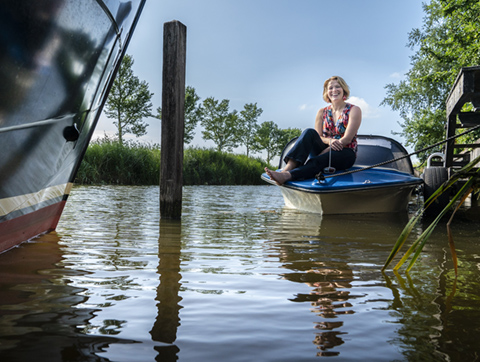
Sustainable coatings
Fighting dirt with a hairbrush
Imagine an ordinary hairbrush. In your mind, throw a handful of marbles of different sizes onto that hairbrush. Do the marbles stay put? Do they fall in between the brush’s bristles? In a proper brush, the bristles will be strong and grouped closely together. As such, the marbles will either slide off your brush, or they’ll even bounce off the bristles.
Annemarie Maan wondered if she could somehow utilise this principle. Would she be able to create a coating that is resistant to dirt particles, just like the hairbrush is resistant to marbles? She’s been working on the problem for three years, but now she knows: it can be done.
Resistance
Maan works as a PhD student at the Zernike Institute for Advanced Materials, where she focuses on sustainable, dirt-resistant coatings for ships and boats. These coatings are important, because dirt on the hull leads to more resistance in the water, which means boats and ships use more fuel if they’re dirty. ‘Clean boats use less fuel and that leads to less oil in the sea’, says Maan.
You can’t go a hundred years without collecting dirt
These kinds of dirt-resistant agents already exist, though: they’re widely available and they work great. However, many of them contain materials such as copper, and dirt-resistant paints often contain toxic material. When the paint peels, this material ends up in the sea water, where they inhibit the growth of plants or kill aquatic animals. Maan has been looking for something that’s more environmentally friendly.
She initially had the idea to copy the principle of the hairbrush exactly. In other words: she wanted to create ‘hairs’ that would keep boat hulls clean. She decided to use polymers, long chains consisting of identical molecules. They can be plastics, or the starch from potatoes or wood cellulose. Maan wanted to attach two different polymers to each other, so they’d work as the bristles in a hairbrush.
Magnets
Because the polymers are oppositely charged, they stick together like magnets, creating a dirt-resistant layer. One side of the layer is water-resistant and attaches to a surface, such as the hull of the boat. The other side is the dirt-resistant side that faces the water.
Sometimes I don’t understand it either
‘The advantage of a two-layer system is that you can wash off the outer layer if there’s too much dirt on the hull’, Maan explains. ‘You can’t go a hundred years without collecting any dirt, no matter how protective the layer is.’
But if there are two layers, you only have to remove the one on the outside. Because the two polymers stick to each other like magnets, this should be relatively easy. ‘It would save time and money in comparison to a single layer that’s applied directly to the boat’, says Maan.
Sphere
Unfortunately, Maan’s idea hasn’t quite worked the way she’d hoped. That’s because the first polymer turns into a little sphere, called a micelle, when it’s applied to a surface. She tried to see if she could break open these micelles, but she’s had no luck so far. ‘It’s been really hard to figure out how it works’, she says. ‘Why was the polymer forming a micelle?’
In the end, she decided to keep working with what she had. Then, something happened that she didn’t expect. The second polymer formed a layer on top of the first layer of spheres. And that layer also consisted of spheres. ‘Except this time, they were surrounded by little threads’, says Maan. If that second layer of spheres is properly nestled into the first layer, these threads create a bristle-like effect after all. She hasn’t figured out yet exactly how this works: ‘Sometimes I don’t understand what’s going on even as I’m doing it.’
Measurement
But Maan’s testing equipment clearly showed that it did work. For the first measurement, she’ll put her home-made layer in a machine that pours dirt particles past the layer. ‘If any dirt sticks to the layer after this test, I won’t be looking any further’, says Maan.
Just when things are getting fun, my time is up
If the layer is in fact dirt-resistant, she’ll be studying what it looks like exactly, taking an extremely zoomed-in photo of the surface. ‘For these photos, we use atomic force microscopy’, she says. ‘It scans the surface with something akin to a needle that moves up and down whenever there’s a height difference. A laser detects this and converts it into an image.’
That’s how Maan first saw that her polymers weren’t in the shape of bristles but round particles, she explains, holding up a photo of a bunch of little spheres next to and on top of each other.
Reality
How the layer will work in reality is difficult to say. There are many factors that affect the polymers, such as the speed at which a boat is travelling, whether it’s travelling through fresh or salt water, as well as the temperature of the water.
‘I would love to study it further’, says Maan. She’d love to set up an experiment in which she immerses ‘her’ layer in a container of ditch water to see how this affects her new substance. ‘But I don’t have the time. Just when things are getting fun, my time is up.’
Maan also admits her layer isn’t truly sustainable. The material contains plastic polymers, and those shouldn’t end up in the water. The crux of the matter is the technique, she says. ‘If that can be finetuned over the next few years, researchers can try to use the same technique with more sustainable materials.’ One option would be biodegradable plastic, for example. ‘They don’t pose a risk to the environment.’